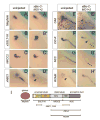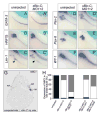Xenopus Bicaudal-C is required for the differentiation of the amphibian pronephros
- PMID: 17521625
- PMCID: PMC1976305
- DOI: 10.1016/j.ydbio.2007.04.030
Xenopus Bicaudal-C is required for the differentiation of the amphibian pronephros
Abstract
The RNA-binding molecule Bicaudal-C regulates embryonic development in Drosophila and Xenopus. Interestingly, mouse mutants of Bicaudal-C do not show early patterning defects, but instead develop polycystic kidney disease (PKD). To further investigate the molecular mechanism of Bicaudal-C in kidney development, we analyzed its function in the developing amphibian pronephros. Bicaudal-C mRNA was present in the epithelial structures of the Xenopus pronephros, the tubules and the duct, but not the glomus. Inhibition of the translation of endogenous Bicaudal-C with antisense morpholino oligomers (xBic-C-MO) led to a PKD-like phenotype in Xenopus. Embryos lacking Bicaudal-C developed generalized edemas and dilated pronephric tubules and ducts. This phenotype was caused by impaired differentiation of the pronephros. Molecular markers specifically expressed in the late distal tubule were absent in xBic-C-MO-injected embryos. Furthermore, Bicaudal-C was not required for primary cilia formation, an important organelle affected in PKD. These data support the idea that Bicaudal-C functions downstream or parallel of a cilia-regulated signaling pathway. This pathway is required for terminal differentiation of the late distal tubule of the Xenopus pronephros and regulates renal epithelial cell differentiation, which--when disrupted--results in PKD.
Figures






Similar articles
-
Patterning the embryonic kidney: BMP signaling mediates the differentiation of the pronephric tubules and duct in Xenopus laevis.Dev Dyn. 2008 Jan;237(1):132-44. doi: 10.1002/dvdy.21387. Dev Dyn. 2008. PMID: 18069689
-
Chordin affects pronephros development in Xenopus embryos by anteriorizing presomitic mesoderm.Dev Dyn. 2007 Jan;236(1):251-61. doi: 10.1002/dvdy.21014. Dev Dyn. 2007. PMID: 17106888 Free PMC article.
-
The RNA-binding protein bicaudal C regulates polycystin 2 in the kidney by antagonizing miR-17 activity.Development. 2010 Apr;137(7):1107-16. doi: 10.1242/dev.046045. Development. 2010. PMID: 20215348 Free PMC article.
-
Towards a molecular anatomy of the Xenopus pronephric kidney.Int J Dev Biol. 1999;43(5):381-95. Int J Dev Biol. 1999. PMID: 10535314 Review.
-
Pronephric duct extension in amphibian embryos: migration and other mechanisms.Dev Dyn. 2003 Jan;226(1):1-11. doi: 10.1002/dvdy.10205. Dev Dyn. 2003. PMID: 12508219 Review.
Cited by
-
Knockdown of bicaudal C in zebrafish (Danio rerio) causes cystic kidneys: a nonmammalian model of polycystic kidney disease.Comp Med. 2010 Apr;60(2):96-106. Comp Med. 2010. PMID: 20412683 Free PMC article.
-
Modeling Renal Disease "On the Fly".Biomed Res Int. 2018 May 31;2018:5697436. doi: 10.1155/2018/5697436. eCollection 2018. Biomed Res Int. 2018. PMID: 29955604 Free PMC article. Review.
-
The polycystin complex mediates Wnt/Ca(2+) signalling.Nat Cell Biol. 2016 Jul;18(7):752-764. doi: 10.1038/ncb3363. Epub 2016 May 23. Nat Cell Biol. 2016. PMID: 27214281 Free PMC article.
-
MicroRNAs are critical regulators of tuberous sclerosis complex and mTORC1 activity in the size control of the Xenopus kidney.Proc Natl Acad Sci U S A. 2014 Apr 29;111(17):6335-40. doi: 10.1073/pnas.1320577111. Epub 2014 Apr 14. Proc Natl Acad Sci U S A. 2014. PMID: 24733901 Free PMC article.
-
Transcriptional control of terminal nephron differentiation.Am J Physiol Renal Physiol. 2008 Jun;294(6):F1273-8. doi: 10.1152/ajprenal.00562.2007. Epub 2008 Feb 20. Am J Physiol Renal Physiol. 2008. PMID: 18287399 Free PMC article. Review.
References
-
- Barr MM. Caenorhabditis elegans as a model to study renal development and disease: sexy cilia. J Am Soc Nephrol. 2005;16:305–312. - PubMed
-
- Barr MM, DeModena J, Braun D, Nguyen CQ, Hall DH, Sternberg PW. The Caenorhabditis elegans autosomal dominant polycystic kidney disease gene homologs lov-1 and pkd-2 act in the same pathway. Curr Biol. 2001;11:1341–1346. - PubMed
-
- Bisgrove BW, Snarr BS, Emrazian A, Yost HJ. Polaris and Polycystin-2 in dorsal forerunner cells and Kupffer’s vesicle are required for specification of the zebrafish left-right axis. Dev Biol. 2005;287:274–288. - PubMed
Publication types
MeSH terms
Substances
Grants and funding
LinkOut - more resources
Full Text Sources

